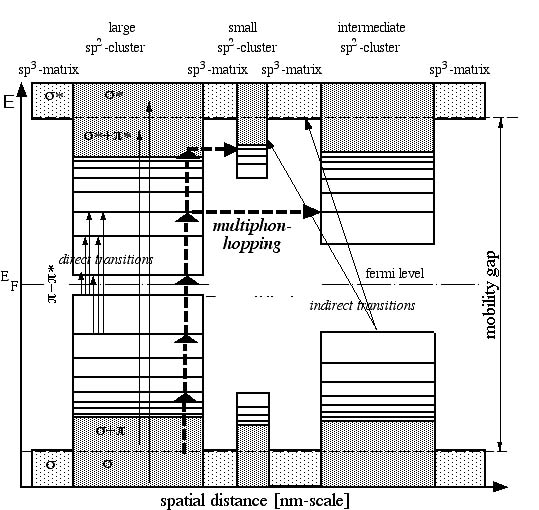 |
Forschungszentrum
Juelich GmbH, AQR and
LIOS;
Johannes Kepler University
Amorphous carbon films, deposited by plasma enhanced chemical vapor deposition
(plasma-CVD) or sputtering are very often treated analogous to amorphous silicon
(a-Si:H), a semiconductor meanwhile very commonly used for electronic (display) or
photovoltaic applications. However, due to the vast range of properties the materials are
sometimes called plasma polymers of diamond like carbon.
In our investigations we were focussing on the electrical and optical properties of
these materials. Just by changing the input power leading to self-bias voltages of between 100
and 1000|V, we were able to change the conductivity of such deposited films by 10 orders of
magnitude (between 10-12 and 10-2 S cm-1) [1]. However, as already reported in this conference [2], at
the same time the optical (as well as the mechanical) properties change. Whereas the films
deposited at 100 V are transparent (and "soft"), their color changes steadily to a very deep black
for the highly conductive and extremely hard as well as chemically resistant films.
As reported before there is a very strong correlation of the optical "absorption edge" and
the conductivity of the films [3]. However, describing the optical properties
in terms of an absorption edge as expected for a classical semiconductor is misleading. Indeed,
adding "doping gases" into the deposition chamber leads to a strong increase of the conductivity
of the films. However, this can also be achieved by adding inert gases such as argon, which do
certainly not lead to a classical doping of carbon [4].
It was shown in further investigation that the electrical properties can best be described by
a multiphonon hopping mechanism as developed by Shimakawa and coworkers [5]. Even the most surprising feature of this model, a characteristic temperature
at which the conductivities of all samples become equal, is in perfect agreement with our data
as determined for a vast number of samples measured in the temperature range between
80 and 550 K. All least square fits to these data point to conductivities between 0.1 and 10 S
cm-1 at 1500 K, although the room temperature conductivities of these samples vary by 10
orders of magnitude.
A careful analysis of the optical parameters of the films [6] as
determined by reflection, transmission and photothermal deflection measurements led to the
surprising result that the absorption behavior below an absorption coefficient of
10-4 cm-1 can be fitted very well by a simple power law. Extrapolating
the absorption to lower excitation energies suggests an increase of the density of states at the
Fermi level accompanying the increase of the electrical conductivity with increasing
self-bias voltage or "dopant" concentration.
Structural investigations were performed by AFM and STM measurements on the surface
of these films [7]. Thereby well defined graphite clusters were identified by
STM measurements on the better conductive samples. The clusters show a preferred
orientation with its planes parallel to the growth direction of the film (i.e. perpendicular to the film
itself), an anisotropy afterwards confirmed by ESR measurements.
In order to get volume informations of the films a detailed NMR study was performed on
powder samples prepared by depositing films on aluminum foils afterwards dissolved in sulfuric
acid. Here, also 13C enriched samples were prepared by depositing films from
13C-enriched ethylene. Various sophisticated solid state NMR techniques were
applied in order to get informations on the graphite cluster sizes by analyzing the coupling and
decoupling rates of protons in the sp3 matrix of the film and the
sp2-13C inside the graphite clusters. These techniques will be be
presented in the talk. Thereby a structure model for our a-C:H films was confirmed as
shown in the figure below. According to this model the optical properties of the films are solely
determined by the graphite cluster size. Multi phonon excitation followed by tunneling of excited
charge carriers through the surrounding sp3-carbon matrix into a neighboring cluster limited by
the tunneling distance then determines the conductivity of the sample [8].
 |
References
| [1] | Peter Hammer, Axel Helmbold, Klaus C. Rohwer and Dieter Meissner: ""Electrical Characterization of Plasma-Deposited a-C:H Films", Mater. Sci Engin. A 139 (1991), 334 - 338 |
| [2] | Peter Hammer, Axel Helmbold, Boris Rubarth, Jan Thiele, Klaus C. Rohwer and Dieter Meissner: "Amorphous Hydrocarbon (a-C:H), Unfortunately no Semiconductor !?", 4th Workshop in QuantumSolar Energy Conversion: Photovoltaics and Photoelectrochemistry, Isola 2000, France, March 30-April 4, 1992 |
| [3] | Klaus Rohwer; Peter Hammer; Jan-Ulrich Thiele; Wolfram Gissler; Peter Blaudeck; Thomas Frauenheim; Dieter Meissner: "Electrical and Optical Properties of Plasma-deposited Amorphous Hydrocarbon Films", J. Noncryst. Solids, 137 & 138, 843 - 846 (1991) |
| [4] | Jan-Ulrich Thiele, Boris Rubarth, Peter Hammer, Axel Helmbold, Barbara Kessler, Klaus Rohwer, Dieter Meissner: ""Ambigous Doping Effects in Amorphous Carbon Films Prepared by PECVD", Diamond and Related Materials 3 (1994), 1103 - 1106 |
| [5] | Axel Helmbold, Peter Hammer, Jan-Ulrich Thiele, Klaus Rohwer and Dieter Meissner: "Electrical Conductivity of Amorphous Hydrogenated Carbon Films", Phil. Mag. B 72 (1995), 335 - 350 |
| [6] | Axel Helmbold, Dieter Meissner: "Optical Absorption of Amorphous Hydrogenated Carbon Thin Films", Thin Solid Films 283 (1996), 196 - 203 |
| [7] | Renate Hiesgen and Dieter Meissner: "Scanning Tunneling Microscopic Studies of Organic and Inorganic Materials for Photovoltaics and Photoelectrochemistry", in: A. Hugot-Le Goff, C. G. Granquist, C. M. Lampert (Ed.): "Optical Materials Technology for Energy Efficiency and Solar Energy Conv. XI: Photovoltaics, Photochemistry, and Photoelectrochemistry", Proc. Europto Ser. Vol. 1729, SPIE, Bellingham, Washington/USA, 1992, pp. 207-217 |
| [8] | Boris Rubarth, Dissertation, Fachbereich Physik der Universität Oldenburg, Juli 2000 |
email: Prof. Dr. Dieter Meissner